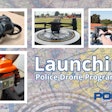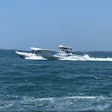It was something out of a movie or TV show. A suicidal man who was about to shoot himself with a .38 revolver was saved by a SWAT sniper. The sharpshooter removed the pistol from his seated target’s hand with a single shot from a .308 rifle. His team members then swarmed in and took the hapless soul into custody without incident or injury.
But it wasn’t a movie and it wasn’t a TV show. This was a real SWAT operation conducted by the officers of a Midwest agency, and the shot that disarmed this potential suicide by cop was heard throughout the law enforcement sniper community.
Everywhere, snipers, tactical commanders, and departmental administrators watched the videotape of this incident and debated the pros and cons of the instantly controversial tactic. Some were impressed and they felt it was a tactic that merited practice and consideration. Others took a more skeptical stance, recognizing the dangers inherent in this course of action.
Magic Bullet
The shot, that day, was absolutely perfect. That .308 round was fired from 65 yards away and struck the revolver at precisely the right point. The weapon broke apart and was rendered inoperable.
More importantly, the subject was unharmed. However, it should be noted that that was a function of chance rather than the sniper’s skill. If you watch the tape of the incident in slow motion, you can clearly see a large piece of metal rip a large hole in the front leg of the subject’s chair. That shrapnel could have just as easily sliced into his leg.
Of course, the people responsible took full credit for the success of their operation. The sharpshooter says he knew exactly where to strike the weapon to make it inoperable and send the parts in a safe direction.
Admittedly, this was a good shot, and it accomplished the intended goal. However, do we realistically attribute this to skill, luck, or a fortuitous blend of both? And is shooting a gun out of a subject’s hand really a reasonable tactical option?
During SWAT Night at my agency’s Citizen’s Police Academy, I showed a tape of this incident. Afterward, I asked the students what they thought of the tactic. Across the board, everyone enthusiastically supported it, saying what a great idea it was, and commenting on how clever reaction by the police saved a life.
I then showed them the other side of the coin. The support quickly evaporated.
What else could have happened? On another day, with another marksman shooting at another weapon, how might the story have ended? This particular incident was highly publicized, appearing in local and national news reports. However, other less-publicized incidents have met with less perfect results. More on that in a minute.[PAGEBREAK]
Objective Study
Let me state up front that I am strongly and vocally opposed to this tactic. First off, preventing an individual from killing himself by shooting at him is frightening, dangerous, and, in most states, illegal. Second, when you shoot a gun out of some guy’s hand in the real world, he doesn’t just simply drop the gun harmlessly to the ground like the bad guy does in an old black-and-white Western movie. In the real world, very bad things can happen when you shoot a gun with a rifle bullet.
But one thing I’ve definitely learned over the years is that if you want your fellow police officers to listen to you, you need to show them proof of your argument. (As a good friend of mine likes to say, “If I can’t show you the math, then it is just my opinion.”)
My decision to mount this project took on greater urgency after another Midwest agency’s sharpshooter shot a gun from the hand of a suicidal individual several months ago. A second incident in the South a few weeks later proved the tactic was still being touted and employed, in spite of the American Sniper Association’s efforts to steer teams away from it. Seeing it written in the sniper team operational manual of a Federal agency was the final straw. So I assembled a research team and we went to work.
This study was conducted by members of the American Sniper Association who set up a controlled series of tests and recorded the results for analysis.
Ours is not the first test of this type; nor is it the definitive, comprehensive study on the topic. It was not our intention to develop statistical probabilities for various outcomes. We don’t have the resources for that. For example, we only shot at 20 different weapons, a sampling that is too small to provide significant statistics. But I still think our results are illuminating.
Our tests were intended to provide anecdotal information and demonstrate a spectrum of possible outcomes. At one extreme, everything can go absolutely right. At the other, everything can go horribly wrong.
Experimental Design
To conduct our tests, we constructed a clamp to hold the test weapons in place. Certainly, the steel vise that we set up held the weapon a lot firmer than any person would grip it. However, for safety purposes, we wanted to limit the movement of the weapons after they were struck by our shots. This precaution was immediately appreciated after the first target firearm discharged on impact.
Foam backers were set up on three sides of the clamping device. White butcher paper was suspended between the cardboard panels. The butcher paper served as “witness panels” and helped us illustrate the flight of any fragments, debris, and bullets in a 180-degree arc around the weapon.
Once we were set up, we fired shots at a variety of weapons, including revolvers, semi-automatic handguns, rifles, and shotguns. Members of the American Sniper Association and the South Florida Community College Video Productions staff documented the entire test. High-speed videotapes and digital still photographs were taken of each shot and its aftermath.
Snipers from the Ft. Lauderdale Police Department and the Collier County (Fla.) Sheriff’s Office fired the test shots. The snipers used bolt-action .308 rifles from a distance of 40 yards. This was done, in part, to help ensure accurate shot placement at precise aim points on the targeted weapons. It was also a concession to the safety of the personnel involved in the testing. Anticipating the possibility of flying debris, we didn’t want to place our shooters too close.
Shooting the Guns
With everything in place, we began our testing.
First, we learned how hard it is to make the perfect shot. The shooters fired from a supported bench rest, and each sniper had to call his shot, designating his intended point of impact. But even under these controlled circumstances, some of the shooters failed to place their first shots exactly on designated aim points.
This proved to us that shooting a weapon from the hand of an agitated person, at any practical distance, is as much luck as it is skill. Don’t kid yourself. Such a shot leaves no margin for error. It is highly possible the shot could hit the subject’s hand instead of the partially exposed weapon.
Our experiment also demonstrated why tactical disarming is dangerous for the subject and all bystanders.[PAGEBREAK]
Shooting a loaded Smith & Wesson .38 revolver in the cylinder resulted in the cylinder exploding in a shower of metal and lead shrapnel when four rounds detonated. Metal fragments and lead fragments penetrated all three witness panels.
Firing a single shot that struck just behind the cylinder area of a .22 revolver resulted in two rounds detonating and the gun exploding in spectacular fashion. Our video team captured footage of the fragments and parts flying in all directions and cutting holes in the witness panels. Some of the recovered parts landed as far as 20 yards away.
OK. So the guns discharge and that might wound or kill the subject. At least it disarms him, right?
Not necessarily. We shot a Makarov handgun in the magazine, twice, but the heavy pistol was still fully functional and capable of firing the round in the chamber. Note: For safety reasons the trigger of the damaged Makarov was pulled remotely with a string.
Shots fired at several long guns also yielded notable results. A Sako 30.06 rifle was shot in the bolt area. The chambered round detonated, blowing a large hole in a witness panel. Examining the weapon, we discovered that the single round in the magazine had also detonated.
Next we fired a .308 into the chamber area of a full-stock Ithaca shotgun. The gun discharged, and the resulting recoil tore it out of the clamp and flung it over the witness panels. A second shotgun discharged a round from the chamber and a round from the magazine tube after being struck near the bolt.
One constant in all of the weapons shot was the significant amount of metal spalling and fragmentation. The witness panels clearly captured this consequence of tactical disarmament.
All but one of the loaded weapons we shot at detonated as a result of being struck, and the rounds were discharged in completely random directions. The danger presented by such unintended gunfire is obvious.
Way Too Risky
So that leads us to this analysis.
On a perfect day, under perfect conditions, a single shot from a high-powered rifle can surgically remove and neutralize a weapon held in the hand of a suicidal subject. There will be no injuries to the subject or bystanders caused by errant rounds and sympathetic discharges. It can be done, but no matter how good a shot you are, you have no real control over what will happen when you fire a .308 into a loaded gun.
If you or your agency are giving any thought to using tactical disarmament as an operational option, you need to recognize that it’s a major gamble and that the results may be disastrous. This is not an easy shot, even when the weapon is immobilized in a clamp. During an actual incident, the targeted weapon is probably going to be in motion and partially obscured by the hand of the person wielding it.
So the weapon is already a small target and it’s probably moving. That’s a hard shot, but you’re probably thinking that a really good sniper can do it. Maybe. But let’s add another variable. You can’t just put your round anywhere into the frame of the gun. To disable the weapon, you have to hit it in a vital spot. And of course, failure to disable the weapon with one shot can lead to tragic outcomes.
Let’s say you do make this incredible shot. You hit the gun exactly in the precise spot to disarm the subject. Here’s what you have done. You have shot a frangible, high-speed, lead projectile at a steel object. As the weapon is struck, there is going to be a significant fragmentation shower. Displaced metal will fly away from the point of impact at all angles, and at speeds in excess of 1,000 feet per second. These fragments will vary in size, but many will be large enough, and traveling fast enough, to lacerate, maim, blind, or kill. There will be no way of predicting or controlling the extent, speed, or direction of the fragmentation.
All of this mayhem is just from your bullet impacting with the metal of the gun. Things get even hairier if the gun is loaded.
In the case of loaded firearms, there is a strong possibility one or more rounds will discharge as a result of being struck by a rifle shot. And if you hit the magazine, the danger of sympathetic detonations increases substantially and a lot more bullets will fly off unpredictably in all directions.[PAGEBREAK]
Deadly Force
Allow me to play devil’s advocate. In most jurisdictions, firing a weapon in the direction of a person, even if there is no intent to hit or harm him, is considered use of deadly force. (Check your state statute.)
So before you consider tactical disarming, it would be a good idea to make sure that it is legal to use deadly force to prevent a threatened suicide in your jurisdiction. You also need to know what the civil and criminal consequences are for the sniper and his agency if fragmentation or errant rounds injure the suicidal subject, a teammate, or innocent bystander.
When It Goes Bad
OK. Earlier in this discussion we looked at some cases of tactical disarming where everything went perfect. Now, let’s look at some where the sniper and his team were not so lucky.
In Oregon, a weapon was shot from the hand of an individual threatening himself and others. The round wounded him and knocked the gun from his right hand. However, as police rushed in, he picked up the still functional gun with his uninjured hand and used it to kill himself.
A robber in Montreal held police at bay by pointing a loaded semi-automatic pistol at his head. The on-scene commander decided to use his snipers to disarm the individual. The round, fired from a distance of 22 meters, went through the magazine well of the weapon. At least one of the rounds in the magazine detonated. The impact, bullet strike, and sympathetic detonation resulted in a broken left arm, as well as the suicidal robber losing two fingers.
Not learning their lesson the first time, the same Canadian team was faced with a suicidal subject a few weeks later. The subject had been firing a rifle randomly in the neighborhood and trying to entice the police to kill him. A sniper was again ordered to disarm the subject. The sniper waited for an opening and shot the rifle away from the subject when it was pointed at the ground. As the arrest team rushed the subject to take him into custody, he picked the gun up and pointed it at the team. Not sure if the gun was still functional, the sniper shot and killed the subject to protect his team.
Better Methods
In talking to agencies that have used this tactic in the past, you hear comments like, “This isn’t in any of the manuals,” or, “If something had gone wrong, his career and mine would be over.”
Then why do it? In dealing with a suicidal subject, there has to be another way. It may require longer negotiations, more patience, or some clever new approach, but a high-velocity disarming technique is not the answer.
History and the experimentation detailed in this article have demonstrated how hazardous this tactic can be. Knowing in advance the high level of risk involved in employing tactical disarmament, any agency choosing to use this tactic should have an unlimited supply of settlement money on hand.
There is no way to guarantee the safety of anyone at the scene of such a shooting. So consider carefully whether or not this is still a viable tactical option. Careers, reputations, and lives may be riding on your final decision.
















